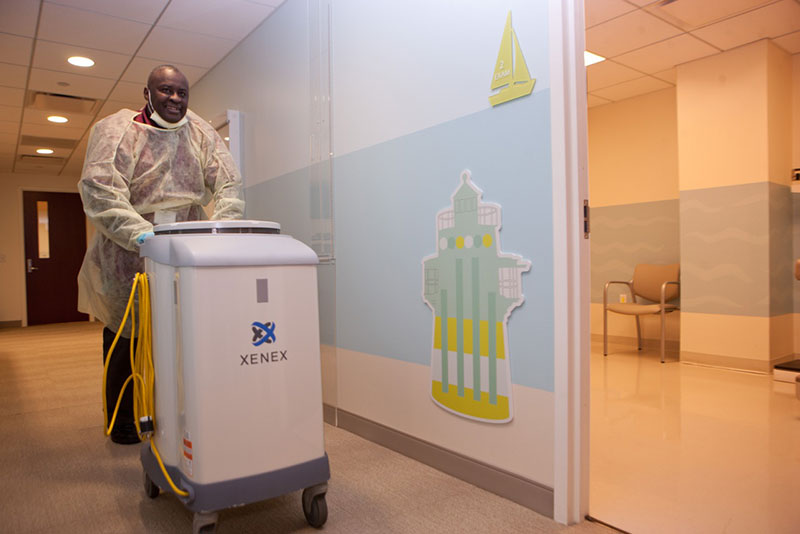Written by Kim O’Brien Root
—
It’s just Albert, doing his job.
Albert is the nickname bestowed on the Newport News hospital’s latest tool in combating germs—a robot used to disinfect rooms. The robot uses pulsating ultraviolet light to kill all major classes of microorganisms on surfaces and in the air, including those that cause infections that can be acquired in hospitals.
Antibiotic-resisting superbugs such as MRSA, Clostridium difficile (C. diff) and Acinetobacter can be a plague for hospitals, causing infection in patients who are already sick. About 2 million people in the United States get hospital-associated infections each year, according to the Centers for Disease Control.
These infections can cause everything from diarrhea and skin infections to pneumonia and death. While there’s been a decrease in MRSA infection rates, in January, the CDC began mandating that health care facilities report cases of infection by C. diff, a stubborn bacterium that causes inflammation of the colon and some 14,000 deaths a year.
For the past few years, Riverside has had a special task force looking at ways to prevent C. diff infection, said Sue Moeslein, the infection prevention nurse manager for Riverside Regional Medical Center. She first heard about Xenex Healthcare Service’s germ-killing robot at a national conference a few years ago and was intrigued.
This year, Riverside became the first hospital in Virginia to purchase the $84,000 Xenex disinfecting system, and on April 18, Albert went into use. The hospital is piloting the robot in three areas—in the medical intensive care unit, and in two units that border the ICU.
After just two months, “we’ve already seen a difference,” Moeslein says. “There’s no question in my mind.”
The simplest way to tell its working? The number of days patients have had to be isolated because of possible C. diff infection has decreased, she says.
Results across the country are promising: One Massachusetts hospital reported an 82 percent decrease in its C. diff infection rate by using the robot, according to Xenex’s website. A Texas hospital reported the elimination of a type of bacteria known as VRE, or Vancomycin-Resistant Enterococci. About 125 hospitals in the U.S. are using the technology.
The robot, an R2D2-sized contraption on wheels, has a column that lifts up, rotates and emits germ-killing beams. It uses pulsed xenon technology to deliver high-intensity, broad-spectrum ultraviolet light. The robot is rolled where it needs to go—in a bathroom or next to a bed, and then left alone for five minutes.
The UV light penetrates the cell walls of microorganisms, rendering them unable to reproduce or mutate. Xenex says the robot cleans 20 times more effectively than current chemical cleaning methods, its UV beams reaching where human hands can’t. It features a motion detector and will shut down if people are in the way.
C. diff spores are resistant to all chemicals but bleach, and can last on surfaces up to five months. Where the robot can really come in handy is when dealing with sensitive medical equipment that can’t be simply wiped down with bleach, Moeslein says.
The robot, however, isn’t intended to replace traditional cleaning methods. The environmental services staff still goes in to scrub down a room after a patient leaves— the robot is brought in afterward for further decontamination. In all, using Albert adds about 10 minutes of cleaning time before it’s available to a new patient.
“It isn’t a silver bullet by any means, but it’s another tool in our array for fighting infection,” Moeslein says. “The bottom line is, I want to do the right thing for our patients. They’re coming to us, looking for us to make them better. That’s what we want to do.”







